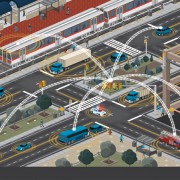Wyoming, Home of America’s Deadliest Highway, Hopes Connected Vehicle Pilot Will Reduce Crashes
Jennifer van der Kleut
One state’s Department of Transportation thinks connected vehicle technology could be the solution to solving the problem of one of the country’s deadliest highways.
Officials say Wyoming’s I-80 is one of the most dangerous highways in America. According to the Wyoming Business Report, there were 50 injuries and one death on I-80 in April 2015 alone. In June, a family of three was killed on the same road.
Therefore, Wyoming’s DOT (WYDOT) announced this month it is turning to connected vehicle technology to try and improve safety on the highway.
The state is currently preparing for tests of a connected vehicle pilot program, in connection with USDOT. Test cars will be outfitted with technology that will allow the cars to communicate with each other, as well as with state infrastructure.
The Business Report says WYDOT is partnering with the University of Wyoming, the National Center for Atmospheric Research, the University of Maryland Center for Advanced Transportation Technology, and Trihydro, an environmental engineering and consulting firm.
Part of the project will consist of installing short-wave communication devices in test vehicles that will allow them to send and receive safety messages.
The second phase of the program will involve installing technology in commercial trucks.
The information they can transmit will include the direction of travel, how fast it is traveling, and whether the vehicle is approaching a dangerous situation, explained WYDOT project manager Ali Ragan.
Though officials say the technology may not be able to eliminate all crashes on I-80 or other similar roads, it may at least help reduce the severity of crashes.
The Wyoming Tribune Eagle reports the technology will also be added to WYDOT’s mobile app, so that even if certain vehicles don’t have the special technology installed, they can view the safety messages through the app.
The first phase of the project is already underway and will continue through September, when the second phase will begin and is expected to last around 20 months. Then a third phase will begin, which will mostly involve analysis of the testing and evaluation of data collected.

